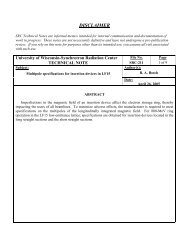SRC Users' Meeting - Synchrotron Radiation Center - University of ...
SRC Users' Meeting - Synchrotron Radiation Center - University of ...
SRC Users' Meeting - Synchrotron Radiation Center - University of ...
Create successful ePaper yourself
Turn your PDF publications into a flip-book with our unique Google optimized e-Paper software.
CHARACTERIZATION OF SULPHATE INTERACTIONS WITH<br />
HEMATITE MINERALS USING XANES<br />
T.Kotzer 1 , J.Cutler 1 , A.Pratt 2 , J.Dutrizac 2<br />
1 Canadian Light Source, <strong>University</strong> <strong>of</strong> Saskatchewan, Saskatoon, Canada<br />
2 Natural Resources Canada - CANMET, Ottawa, Canada<br />
Sulphur bearing hematite is a product <strong>of</strong> some novel hydrometallurgical sphalerite<br />
treatments. Leaching tests aimed at investigating the stability <strong>of</strong> the hematitic leach residue have<br />
shown that only a fraction <strong>of</strong> the sulphur present is removed. In this study sulphur bearing<br />
hematites were leached in a variety <strong>of</strong> media and examined using XANES Sulphur K-edge and<br />
L-edge spectroscopy at the Canadian <strong>Synchrotron</strong> <strong>Radiation</strong> Facility, <strong>SRC</strong>-Madison, WI, to<br />
address questions regarding the chemical environment, oxidation state and physical distribution<br />
(surficial versus intercrystalline) <strong>of</strong> the sulphur within the hematite minerals. XANES S K-edge<br />
FY and TEY and L-edge TEY spectra indicate that the sulphur predominantly occurs as sulphate<br />
having a formal oxidation state <strong>of</strong> S 6+ and is largely distributed within the hematite matrix at<br />
concentrations between approximately 0.04 and 4.7 %. The XANES S K- and L-edge absorption<br />
spectra have also been used to assess the effectiveness <strong>of</strong> leach treatments employing HNO 3 and<br />
NH 4 OH solutions for the removal <strong>of</strong> sulphate from the hematite minerals. Here, the spectra<br />
indicate that a 0.05M HNO 3 solution was largely ineffective at removal <strong>of</strong> surficial and<br />
intercrystalline sulphate whereas 1 to 4M NH 4 OH leach solutions appear to have variably<br />
removed sulphate from the uppermost regions (5 to 30 nm depth) <strong>of</strong> the hematite minerals.<br />
Overall integration <strong>of</strong> the XANES S K-edge and L-edge TEY and FY spectra provides both<br />
unique information regarding the distribution <strong>of</strong> sulphate within the hematite matrix and a means<br />
to evaluate the effectiveness <strong>of</strong> leach processes used to remove sulphate from hematite minerals.
















